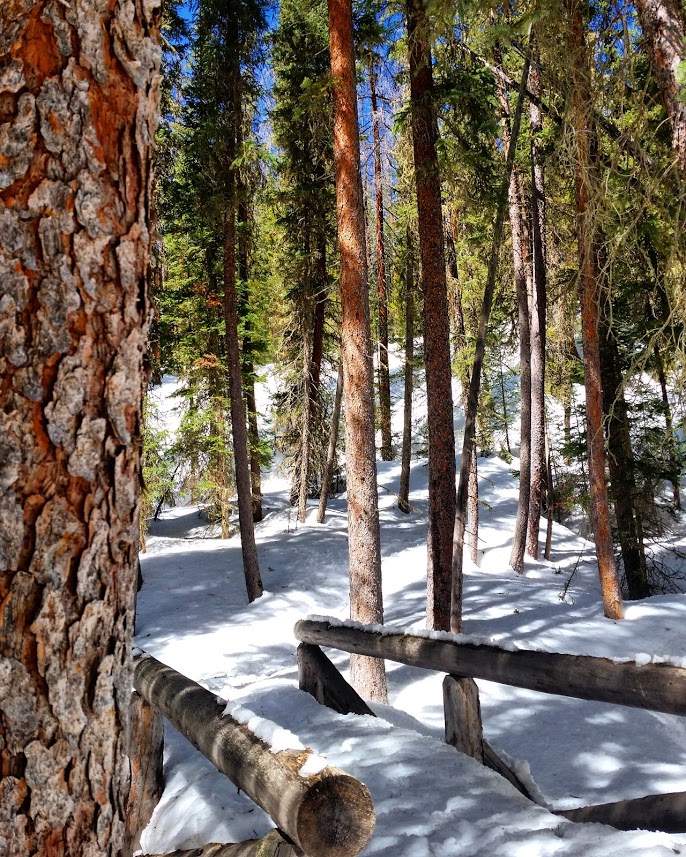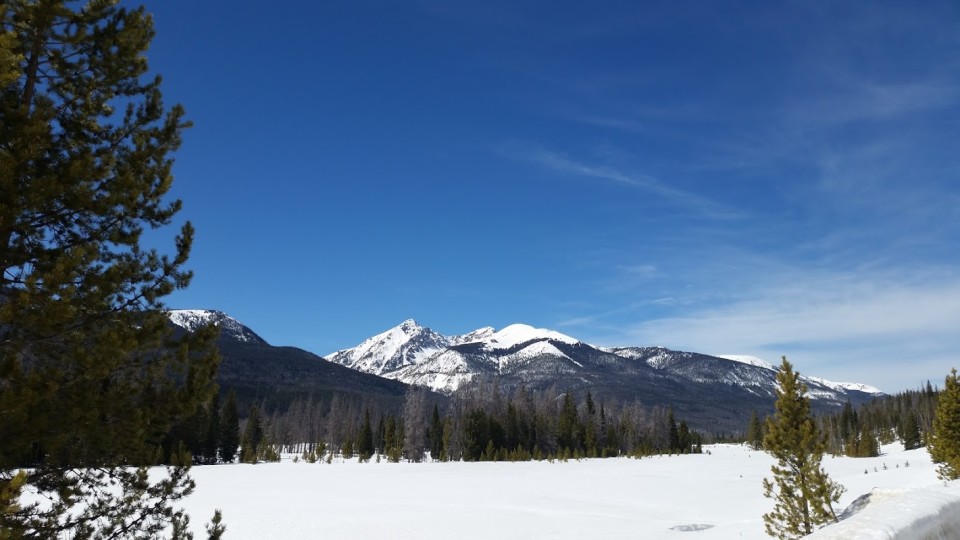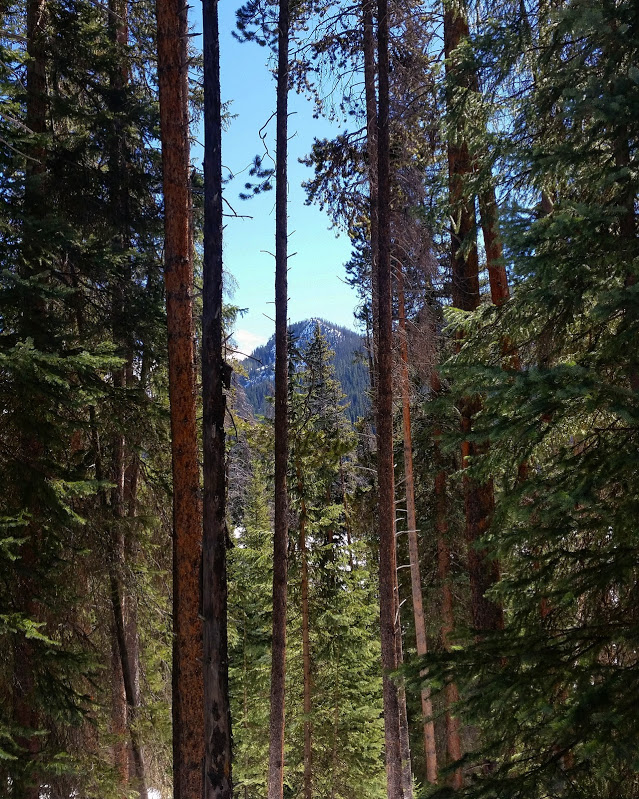I do believe so…
I hiked and snowshoed 8 miles a couple days ago up in Rocky Mountain National Park. 8 miles. Gaining and losing elevation through a beautiful forest, passing by snow blanketed meadows and catching glimpses of mountain peaks. It was sunny and warm, there were no bugs, no people, no cell service.
For about 7 miles of it I was on a trail that hadn’t been traversed by a human in a few days and sometimes the snowshoe tracks disappeared completely (but there were plenty of moose and rabbit tracks and paw prints from coyote, fox, or bobcat). I’d pretty much characterize that as living well.
It was absolutely wonderful. Especially since there was a time (a long time) I thought I’d never be able to do things like this again.
But there was a time where just walking Buster around the block was painful. Where my every thought was about my hip, about what was going on in there, about pain. I was so fixated on it, I could never enjoy the walk itself, the fresh air, the trees, the chats with the neighbors.
I didn’t go for hikes because I knew it would flare me up. I was depressed and frustrated. Prior to my injury my time on the trail was my me time, my time to get out and stop thinking and just move. It sucked no longer having that release, that freedom, that sense of accomplishment that comes with physical exertion, sweat, and miles.
I lost a part of myself, in part because I believed I couldn’t do those things any more because of my chronic pain. I thought I had to wait for the pain to be gone to engage in life again.
What is success when it comes to treating or managing chronic pain?
This is a topic that gets debated quite a bit in chronic pain treatment circles. What ought the end goal of treatment be? What success looks like. Is it being pain-free? Is it living well with pain? Yes, I’ve talked about it before, but I think it’s important to keep talking about it.
I used to be in the success=pain free camp for a long time, so I understand the notion. It makes intuitive sense that the goal of chronic pain treatment should be be alleviate and eventually eradicate pain. But when I was in that camp I found that I had put my life on hold until I could attain success, until I was pain-free.
I was waiting, anxious and uncertain because when would success happen? How long would I have to wait for to be pain free so I could get on with living? What would I do in the meantime? And what if I was never successful?
The emotional roller coaster of elusive cures
In that desire for a cure, for a successful pain-free outcome, I experienced a constant, exhausting, roller coaster of emotions. The exhilarating highs and stomach flipping lows, excitement and fear, anticipation and disappointment.
I never got a break from it, there was no get-off point, the roller coaster never came to a stop. The anticipation was constant, the end point nowhere in sight, the uncertainty difficult to bear.
When my pain was at it’s worst I was in constant hope of finding the person or method or therapy that would “fix me”. Whenever I found the next person/method/therapy I would do it to the nth degree, and I would believe with all my heart (or at least really really try to believe with all my heart) that it was going to work, that my pain would be cured.
I went through physical therapy, cortisone injections, surgery, more physical therapy, yoga, massages, acupuncture, chiropractors, posture-based movement therapy, changing my diet, mindfulness training…you name, I tried it.
With each new therapist, each new treatment, each new attempt I was desperate for it to work, desperate for me to be fixed.
And with each new therapist, each new treatment, I was devastated when I wasn’t.
Oh, I would see some successes, especially when I was receiving the treatment itself. But as soon as I got home again, to life, to my worries, fears, anxieties, to my routines and habits, the pain would always come back. Sometimes in hours, sometimes days. Sometimes I even got a week or two of relief. Of hope that I was cured, that the pain was gone for good.
But the pain would always come back. Often times less, but always back. And sometimes worse.
I failed, over and over and over again
Nothing ‘stuck’, no matter how diligent I was. I would always have another flare and each flare would feel more devastating than the last. It was as though getting a taste of being pain-free made me forget what the pain was like, even if I was only pain free for a brief time. And when it came back it was like BAM!, being hit by a truck. Totally unexpected, life-altering, painful. Every frickin’ time!
Why? Because for the longest time I wasn’t aware that there was no quick fix, let alone that there really wasn’t a good fix at all. I didn’t know that flare-ups were common, to be expected, and that I was wholly capable of handling them on my own. I didn’t know that it was possible to keep pursuing life while the pain was still present, that I didn’t have to wait for it to be gone to pursue a life worth living.
But what if success looked different? What if it wasn’t being pain-free?
When my definition of success was being pain-free, I was continually set up for failure.
But things changed when I realized that maybe my pain was going to stick around for a while. When I started to learn about the science of pain and that my pain didn’t mean the tissues in my hip were torn up, ragged, tattered bits that could never work right again. When I learned that moving wasn’t hurting me, that it was helping me, even when I still had pain.
It took a while but I began to accept that pain was a part of my life at that moment and that I ought to learn how to live with it if I wanted to get back to living somehow, without having to wait. None of us are guaranteed tomorrow, after all.
Acceptance
By accepting pain as part of my reality, I could finally get off the roller coaster and start living again, not in anticipation of a better future but rather with the intent of a better now. Today is our reality, not what might be tomorrow, not what once was a long time ago.
Success no longer meant being pain free, success was living the best I could right now. Today. Success meant taking ownership of my pain management, doing the things that I knew helped, continually educating myself and exploring new things, and reassuring myself that I was on the right path.
And my pain actually got better. Way better. It was a huge relief to not have to keep searching for the next fix, the next cure, the next magic man. Once I stopped that search, it freed up time and resources to get back to the things I had put on hold. Like hiking. Like life.
It’s not giving up or removing hope, it’s giving hope
Even though my definition of success changed from one of being pain free to one of living well with pain, it didn’t mean I’d given up hope that one day my pain will be gone for good. I just wasn’t banking on it happening in order to live a valued, meaningful, purposeful life anymore.
Why do I keep harping on this? I think it’s important because some folks worry that talking about living well with pain implies giving up. So I want to make it clear that it is the exact opposite of giving up, it’s giving living a chance again. It opens up the opportunity to live well right now without having to wait anymore. If the pain does go away, wonderful! We already have the living well part down. And if it doesn’t go away? We still have the living well part down.
It’s important how the message is framed and understood, though. I don’t think saying “this is never going to go away so learn to live with it” is helpful. It is pretty negative and carries with it the sense of being loaded down with this burden of pain for life and trying to figure out how to manage with that burden. Like you’re going to be carrying around a brick shithouse on your back for the rest of your life. That sucks, no one wants to hear that.
But what if it’s more like “pain is a part of your current reality, let’s work out how you can still pursue the things that matter most to you right now, even it it’s presence, while you’re undergoing treatment”. That opens the door for both therapy and living well simultaneously, without having to wait for therapy to be successful in order for the living well to happen.
This eases the burden on both patient and practitioner, doesn’t it?
Living well right now
One day my pain may go away completely, that’d be awesome. I actually think this is possible, I’m much closer to that day than I have been in over 6 years, that’s for sure.
Or I might stay where I’m at, highly functional, exploring and discovering new things with each passing day, being active, pursuing stuff that matters to me, all while there’s some pain in the background from time-to-time that sometimes flares up and comes to the foreground. I think that’d be awesome, too, because my life is good right now.
That’s the kicker, folks. If I weren’t to at least acknowledge that the pain might be for keeps, I’d be stuck waiting to fully live and that’d really suck. Yes, my pain might someday be gone, but what if I don’t live long enough to see that day?
After all, who knows if I’ll die in old age or if I’ll get trampled by a moose next time I’m up in Rocky Mountain National Park…
Actual moose spotted on one of my snowshoes in Rocky Mountain National Park
The crazy thing is, once we can start thinking this way, our pain can bet WAY better. Way better. It seems counter-intuitive. Many of us think the only way forward is to be rid of pain but, paradoxically, it may just be that the only way we can ever become pain free, if it’s possible, is through being ok with living with pain.
The bottom line is that whether I had a week or 50 years, I wanted to live my life and didn’t want to wait anymore. I wanted to hike, dammit. And when I stopped waiting and started living, life became pretty damn awesome again.
I was able to work up to hiking again. Short distances at first, close to home, then gradually increasing my time out or getting into more difficult terrain. And that gradual increasing, that flexible persistence, got me to here, to snowshoeing 8 miles in Rocky Mountain National Park, experiencing the beauty, awe, solitude, and peace of being out in nature, feeling the sense of accomplishment that getting out on a trail gives me, all the while not even thinking about my hip, other than to think, hey, I’m not thinking about my hip!
It’s pretty freaking awesome.
This is my reward for months and years of flexible persistence. Months and years that were totally worth it. And there are more months and years to come (barring being trampled by a moose) and I’m so excited to see what they will bring.
Success is focusing on what we can do, what we want to do, what is meaningful to do, and what is possible to do RIGHT NOW. It’s living a series of right nows, and who knows where it will take us. At least that’s what success is for me, whether I have pain or not.
What is it at for you?
Thanks for reading my long-ass post, folks! One of these days I’ll do a micro-post. I’m inspired by Paul Ingraham over at PainScience.com, maybe one day I’ll be able to do it. Maybe. As always, I’d love to hear from you! Leave a reply, send me an email via the contact form, or hit me up on social media. I’d love to chat. And thank you thank you thank you for your ongoing support, kindness, and encouragement. MyCuppaJo wouldn’t be here if it weren’t for all you awesome folks.
P.S.
For those interested in how I have succeeded with this whole living well thing, I have written some posts on things that have helped me the most, things like getting out into nature by hiking, snowshoeing, camping, walking, exploring, and snowboarding; being creative by taking pictures, writing, and coloring; mindfulness strategies such as my Headspace App, body scans, and breathing exercises; pain science education; talking with others about their experiences and sharing my own; and movement which isn’t just done on it’s own, it’s sprinkled throughout all of my other strategies. Mindful movement is fave :)
If you’d like help figuring out what might work best for you, I suggest checking out the newly launched Live Plan Be by Pain BC, an online resource to help you manage your pain in a way that is unique and meaningful to you. One of my favorite painiacs, Dr. Bronnie Lennox Thompson, was a contributor to it’s creation so you know it’s top notch! Another resource is my friend Pete Moore’s Pain Toolkit.




Pingback: Living well with chronic pain, is it possible? | EDS Info (Ehlers-Danlos Syndrome)
Pingback: Living Well With Chronic Pain - One to One Wellness
Pingback: Living Well With Chronic Pain - New WP Site
Pingback: Living Well With Chronic Pain - Physiotherapy Halifax - Physio-Fitness - One to One Wellness